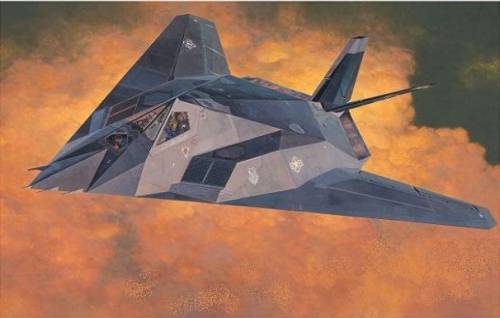Die F-117 im Krieg gegen Jugoslawien
- Übersetzung Manfed Rassau 2009

Im Mai 1999 tobte in Europa wieder Krieg. Diesmal gegen Jugoslawien.
Dabei kamen erstmals die F-117 „Night Hawks“ zum scharfen Einsatz.
Dabei kamen erstmals die F-117 „Night Hawks“ zum scharfen Einsatz.
Ein Tarnkappenbomber der USA, der vom Radar nicht erkannt werden sollte.
Sie sollten im Schutze der Nacht Angriffe gegen Objekte der jugoslawischen Luftverteidigung fliegen. Zum Einsatz kamen hauptsächlich lasergelenkte Bomben.
Verschiedenen Informationen zur Folge, wurden sie bei ihren Einsätzen ständig durch Flugzeuge des funkelektronischen Kampfes gedeckt.
Allgemein wurde in der US-Presse relativ weniger über die Teilnahme der F-117A an diesem Krieg in Europa berichtet, als bei den Einsätzen im Golfkrieg.
Daraus könnte man schließen, dass auf dem Europäischen Kriegsschauplatz weniger Erfolge erzielt wurden.
Der Konflikt auf dem Balkan beendete schließlich das Gerücht von der Unverwundbarkeit des Stealth-Bombers.
Die Vernichtung der ersten F-117A mit Pilot Captain K. Dzilly am Steuer während des dritten Kampftages am 27. März gegen 21 Uhr war für die USA ein echter Schock. Die Maschine war 32 Kilometer von Belgrad entfernt abgeschossen worden.
Zu deren Vernichtung gibt es mehrere Versionen:
Durch Raketen des Komplexes „Kub“, durch Abfangjäger MiG-29 oder durch Beschuss mit Flak-Artillerie.
Möglicher weise waren an der Bezwingung dieser F-117A verschiedene Mittel der Serben angewendet worden. Dabei ist es schwer zu entscheiden, wem dabei der größte Verdienst zukommt.
Nach Worten des US-Piloten kam die Attacke gegen sein Flugzeug vollkommen unerwartet.
Sein Warnsystem hatte nicht angesprochen.
Pilot Dzilly konnte sich mit seinem Schleudersitz retten. Er versteckte sich vor der jugoslawischen Polizei in einer Höhle. Sieben Stunden später fand ihn eine US-Suchtruppe, die den Piloten zur Luftwaffenbasis Aviano in Norditalien brachte.
Bei dieser Such- und Rettungsoperation wurde ein Hubschrauber vom Typ HH-60 „Pipe Hawk“ bei der Ortschaft Uglewik abgeschossen. Nur zwei Mann der Besatzung überlebten den Absturz und kamen in Gefangenschaft.
Am 1.April 1999 mußte eine andere F-117A auf dem Flugplatz Plezo bei Zagreb auf gegnerischem Gebiet notlanden. Sie hatte schwere Kampfschäden erhalten.
Noch ein weiterer Tarnkappenbomber ging nach Angaben Serbiens am 5. April bei Attacken gegen den Fernsehturm „Zrewni Kot“ verloren.
Der Pilot katapultierte sich und landete im Bereich des Dorfes Remete.
Am 2. Mai meldeten die Serben, dass eine MiG-29 über dem Kosovo noch eine weitere F-117A abgeschossen hatte.
Die Folgen dieser Verluste erwiesen sich für die US-Amerikaner schlimmer als erwartet. Bald wurden nur kursierende Gerüchte bestätigt, dass die Überreste eines der über Jugoslawien abgeschossenen „Stealth“-Bomber nach Russland gebracht wurden, wo sie gründlich untersucht worden sind.
In der Nr.5 des Journals „Aviation week“ vom 5. Oktober 2001 findet sich eine Reportage aus Shukowski. Darin gaben nicht genannte hochrangige Persönlichkeiten der russischen Luftfahrtindustrie zu, dass die Reste der F-117A verwendet wurden, um der russischen Luftverteidigung bessere Möglichkeiten zum Orten und Vernichten von Flugzeugen und Flügelraketen mit geringer Sichtbarkeit geben zu können.
Ob die Erforschung von über 20 Jahre alten Technologien die russische Wissenschaft voranbringt, ist zweifelhaft.
Doch fremde Geheimnisse in der Hand zu haben ist immer nützlich.
Sie sollten im Schutze der Nacht Angriffe gegen Objekte der jugoslawischen Luftverteidigung fliegen. Zum Einsatz kamen hauptsächlich lasergelenkte Bomben.
Verschiedenen Informationen zur Folge, wurden sie bei ihren Einsätzen ständig durch Flugzeuge des funkelektronischen Kampfes gedeckt.
Allgemein wurde in der US-Presse relativ weniger über die Teilnahme der F-117A an diesem Krieg in Europa berichtet, als bei den Einsätzen im Golfkrieg.
Daraus könnte man schließen, dass auf dem Europäischen Kriegsschauplatz weniger Erfolge erzielt wurden.
Der Konflikt auf dem Balkan beendete schließlich das Gerücht von der Unverwundbarkeit des Stealth-Bombers.
Die Vernichtung der ersten F-117A mit Pilot Captain K. Dzilly am Steuer während des dritten Kampftages am 27. März gegen 21 Uhr war für die USA ein echter Schock. Die Maschine war 32 Kilometer von Belgrad entfernt abgeschossen worden.
Zu deren Vernichtung gibt es mehrere Versionen:
Durch Raketen des Komplexes „Kub“, durch Abfangjäger MiG-29 oder durch Beschuss mit Flak-Artillerie.
Möglicher weise waren an der Bezwingung dieser F-117A verschiedene Mittel der Serben angewendet worden. Dabei ist es schwer zu entscheiden, wem dabei der größte Verdienst zukommt.
Nach Worten des US-Piloten kam die Attacke gegen sein Flugzeug vollkommen unerwartet.
Sein Warnsystem hatte nicht angesprochen.
Pilot Dzilly konnte sich mit seinem Schleudersitz retten. Er versteckte sich vor der jugoslawischen Polizei in einer Höhle. Sieben Stunden später fand ihn eine US-Suchtruppe, die den Piloten zur Luftwaffenbasis Aviano in Norditalien brachte.
Bei dieser Such- und Rettungsoperation wurde ein Hubschrauber vom Typ HH-60 „Pipe Hawk“ bei der Ortschaft Uglewik abgeschossen. Nur zwei Mann der Besatzung überlebten den Absturz und kamen in Gefangenschaft.
Am 1.April 1999 mußte eine andere F-117A auf dem Flugplatz Plezo bei Zagreb auf gegnerischem Gebiet notlanden. Sie hatte schwere Kampfschäden erhalten.
Noch ein weiterer Tarnkappenbomber ging nach Angaben Serbiens am 5. April bei Attacken gegen den Fernsehturm „Zrewni Kot“ verloren.
Der Pilot katapultierte sich und landete im Bereich des Dorfes Remete.
Am 2. Mai meldeten die Serben, dass eine MiG-29 über dem Kosovo noch eine weitere F-117A abgeschossen hatte.
Die Folgen dieser Verluste erwiesen sich für die US-Amerikaner schlimmer als erwartet. Bald wurden nur kursierende Gerüchte bestätigt, dass die Überreste eines der über Jugoslawien abgeschossenen „Stealth“-Bomber nach Russland gebracht wurden, wo sie gründlich untersucht worden sind.
In der Nr.5 des Journals „Aviation week“ vom 5. Oktober 2001 findet sich eine Reportage aus Shukowski. Darin gaben nicht genannte hochrangige Persönlichkeiten der russischen Luftfahrtindustrie zu, dass die Reste der F-117A verwendet wurden, um der russischen Luftverteidigung bessere Möglichkeiten zum Orten und Vernichten von Flugzeugen und Flügelraketen mit geringer Sichtbarkeit geben zu können.
Ob die Erforschung von über 20 Jahre alten Technologien die russische Wissenschaft voranbringt, ist zweifelhaft.
Doch fremde Geheimnisse in der Hand zu haben ist immer nützlich.
Quellen:
http://airwar.ru/history/locwar/europe/f117/f117.html
http://airwar.ru/history/locwar/europe/f117/f117.html
